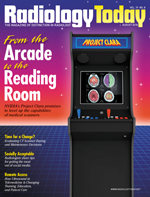 Interventional News: Evolving Ecosystems
Interventional News: Evolving Ecosystems
By Dave Yeager
Radiology Today
Vol. 19 No. 8 P. 5
Teamwork drives medical innovation.
Despite popular belief, innovation rarely follows a linear path. Usually, it requires incremental contributions from different disciplines to create a breakthrough technology. In the medical field this is especially true.
In the early 1960s, M. Stephen Heilman, MD, an emergency department physician, saw a need for better visualization tools to detect injured blood vessels on coronary arteriograms. He approached Mark Wholey, MD, a radiologist, about developing a contrast injector. Working in Heilman's basement, the two doctors went on to develop the first flow-controlled contrast injector—after scrapping their original hydraulic model for an electric motor-driven design—and their invention led them to cofound Medrad, Inc, now part of Bayer.
"At that time, angiographic studies were being done by direct puncture because they didn't have flow-specific injectors. We were just pulling down on a handle, and we had no idea what the pressure was," Wholey says. "So, depending on the vascular compartment, we calculated the flow, and everything was dependent on the flow analysis to have specific rates for different compartments of the body. The extremities are different from the aorta. The aorta is much different than the carotid. And the carotid is quite similar to the coronary, but the left ventricle is similar to the aorta. All of these different compartments of the body have different flow rates. We established that and stabilized that so it became common terminology."
By the early 1970s, Medrad's injectors accounted for about 70% of the world market, but the advent of CT and, later, MRI changed the market.
"The introduction of computed tomography and MRI was an entirely new phase," Wholey says. "Computed tomography changed the dynamics. Adjusting the fluid control for CT angiography (CTA) became extremely popular for all phases of aneurysm, and that was popular in the mid-1980s. In the mid-1990s, MRI came into play. So CT and MRI moved injectors to a whole new, unbelievable phase. Their impact was every bit the equivalent of the early angiogram."
Innovation Happens
Since the introduction of CT and MRI, contrast imaging uses have continued to evolve. Ned Uber, PhD, the head of radiology device research and development at Bayer, says adapting injectors for CT dramatically reduced the time it takes to assess stroke patients, which is important for staging. He also notes that the switch to nonionic contrast and the realization that it could be supplemented with saline led to the invention of dual injectors. In addition, the development of CT scanners that can image an entire organ, such as the heart, in one pass, has made CTA possible.
"You design a product for one medical use, but then we're part of an ecosystem," Uber says. "And the ecosystem includes the contrast, the injector, the imaging companies, and the doctors and researchers. So all of us take the tools that the other people provide and innovate the best we can because we're all trying to solve patients' clinical needs. Each of us brings one expertise, and we count on the others."
Uber says the direction of innovation is not always easily charted but, sooner or later, innovation happens. Tighter integration between injectors and scanners is one area that he sees as an evolutionary step in patient care. Uber cites Medrad's privacy preferences platform as an example. The platform allows the injection system to receive input about patients and suggest protocols, reducing the amount of information that technologists need to input.
"The less the technologist has to touch it, the less chance there is for error, and the easier it is," Uber says. "The more fully the injector is integrated with the scanner and the more people who use that technology, the less contrast that is used and the better images you're going to get. And the less radiation dose, for that matter."
Another example is the integration of Medrad's Stellant injector with Siemens Healthineers' Somatom go. platform. The injector is mounted on the arm of the scanner, rather than the ceiling, allowing greater mobility. On the horizon, Uber says there are a couple of clinical questions—he calls them medical Mt. Everests—that he thinks will ultimately be answered by the ecosystem, rather than a single entity.
One of those questions involves the use of contrast to screen women with dense breasts. MRI, abbreviated MRI, contrast-enhanced digital mammography, contrast-enhanced spectral mammography, and even contrast-enhanced breast CT are among the contenders to better image dense breasts, but there isn't yet a consensus about which protocols are best.
The second question relates to the need for a noninvasive exam to act as a gatekeeper for the cardiac catheter lab. A noninvasive test to rule in or out the need for an angiogram would greatly enhance patient care and save a significant amount of money, but, again, there is no consensus about whether CTA or an abbreviated MR with contrast is the best method, Uber says.
However these clinical problems end up being solved, Uber believes the solutions will have many parents.
"It's a little bit hard to predict new uses of technology, but there are bound to be a lot of amazing things happening, as long as we keep innovating, and it's better if we all work together," Uber says. "The innovation is going to happen as fast as we all can do it, not individually, but as an ecosystem."
— Dave Yeager is the editor of Radiology Today.

